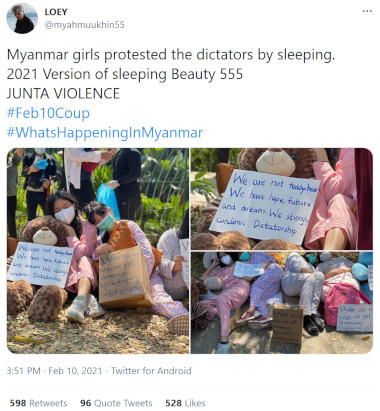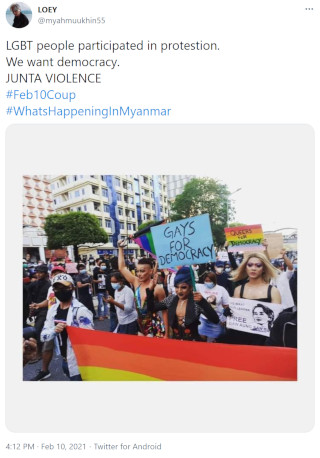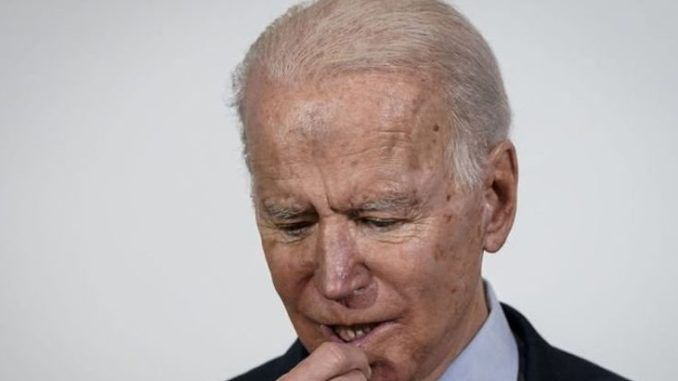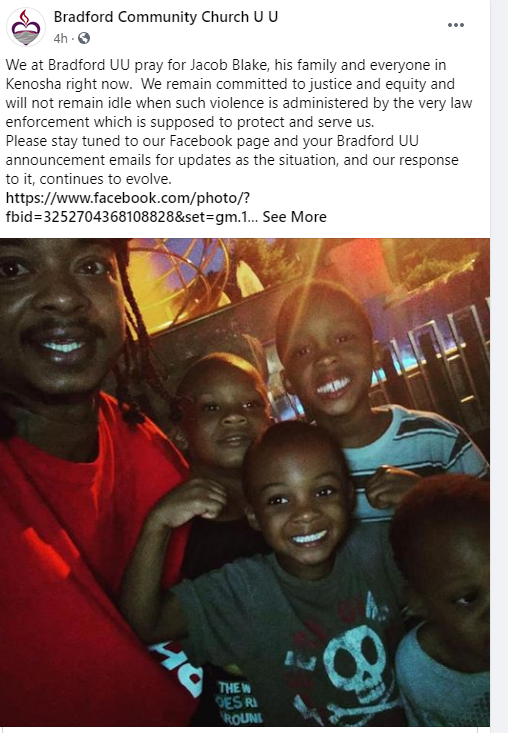On February 1 the military of Myanmar, the Tatmadaw, launched a coup d’état. President Win Myint and State Counsellor Aung San Suu Kyi were detained, along with ministers and their deputies and members of the parliament. They were accused of some minor crimes and will be kept off the streets for some time. Aung San Suu Kyi party, the NLD which had widely won the latest election, will be prohibited.
All that was not astonishing and is unlikely to make a big difference in the politics within and towards the extremely complex country:
There’s no smoking gun, of course, but it’s virtually impossible that Beijing had not been at least informed, or “consulted”, by the Tatmadaw on the new dispensation.
China, Myanmar’s top trade partner, is guided by three crucial strategic imperatives in the relationship with its southern neighbor: trade/connectivity via a Belt and Road Initiative (BRI) corridor; full access to energy and minerals; and the necessity of cultivating a key ally within the 10-member ASEAN.
…
None of that will change, whoever runs the politico-economic show in Myanmar’s capital Naypyidaw. Chinese Foreign Minister Wang Yi and Aung San Suu Kyi, locally known as Amay Suu (“Mother Suu”) were discussing the China-Myanmar economic corridor only three weeks before the coup. Beijing and Naypyidaw have clinched no less than 33 economic deals only in 2020.
…
Yet this is not all about China. The Tatmadaw coup is an eminently domestic affair – which involved resorting to the same old school, CIA-style method that installed them as a harsh military dictatorship way back in 1962.
The NLD and Suu Kyi had simply become to assertive and threatened to touch the commercial businesses the military runs. That could not be condoned.
There are several ethnic insurgencies ongoing in Myanmar. There is are a lot of warlords and off the record drug and weapon business. The NLD did not care about that nor will the military:
The [election] end result privileged the NLD, whose support is negligible in all border regions. Myanmar’s majority ethnic group – and the NLD’s electoral base – is the Bamar, Buddhist and concentrated in the central part of the country.
The NLD frankly does not care about the 135 ethnic minorities – which represent at least one third of the general population. It’s been a long way down since Suu Kyi came to power, when the NLD actually enjoyed a lot of support. Suu Kyi’s international high profile is essentially due to the power of the Clinton machine.
If you talk to a Mon or a Karen, he or she will tell you they had to learn the hard way how much of an intolerant autocrat is the real Suu Kyi. She promised there would be peace in the border regions – eternally mired in a fight between the Tatmadaw and autonomous movements. She could not possibly deliver because she had no power whatsoever over the military.
Without any consultation, the electoral commission decided to cancel voting, totally or partially, in 56 cantons of Arakan state, Shan state, Karen state, Mon state and Kachin state, all of them ethnic minorities. Nearly 1.5 million people were deprived of voting.
While Suu Kyi once had ‘western’ support, they gave her a Nobel Peace Prize, that has long been lost:
Suu Kyi’s biggest mistake was believing that she could, through her brand of nationalism, dismiss accusations of genocide directed against the Rohingya. In the process, she lost Western support. From that point, she has been on borrowed time, and the military barely hid its distaste for her.
To be sure, the military anticipated the impact and the reaction from the international community and took into consideration the new US administration’s preoccupations with domestic issues. Myanmar doesn’t even figure in the top 10 priorities of President Joe Biden’s foreign policy.
Given the above it is astonishing to see that only a few days after the coup happened the country is already experiencing a U.S. style color revolution.
Just consider this ABC News ‘Explainer’ which is typical for color-rev reporting:
EXPLAINER: How are the Myanmar protests being organized?
For the most part the protests have grown organically.
“This movement is leaderless — people are getting on the streets in their own way and at their own will,” said Thinzar Shunlei Yi, a prominent activist.
Activist groups, professional work groups, unions and individuals across Myanmar have all come out in opposition to the coup, as has Suu Kyi’s National League for Democracy party.
…
Health care workers also started a protest campaign, wearing red ribbons, holding signs and urging other medical staff to not work at state-operated health facilities.Street protests over the weekend featured the heavy presence of unions, student groups and other groups representing professions as diverse as park rangers and book printers.
Yangon residents have voiced dissent by banging pots and pans together across the city at night.
…
Making the rounds have been copies of safety protocol information sheets, some of them originally from Hong Kong, with instructions on how to encrypt communications and how to stay safe during protests.
“The movement is leaderless,” said one of its longtime leaders who is well known to this ‘western’ reporter. …
The highlighted points are all standard attributes we have seen in other color revolutions around the world. This type of reporting by Reuters is also quite typical:
Myanmar’s anti-coup protesters defy crackdown with humour
Protesters returned to the streets of Myanmar on Wednesday despite the shooting of a young woman the previous day, with some deploying humour to emphasise their peaceful opposition to this month’s military takeover.
…
“We cannot stay quiet,” youth leader Esther Ze Naw told Reuters. “If there is blood shed during our peaceful protests, then there will be more if we let them take over the country.”There were no reports of violence on Wednesday and in many places protests took on a festive air, with bare-chested body builders, women in ball gowns and wedding dresses, farmers in tractors and people with their pets. Some set up a protest line in inflatable rubber tubs.
Thousands joined demonstrations in the main city of Yangon, while in the capital, Naypyitaw, hundreds of government workers marched in support of a growing civil disobedience campaign.
…
Earlier, soldiers took over a clinic that had been treating wounded protesters in Naypyitaw on Tuesday, a doctor there said.The teenager was shot when police fired, mostly into the air, to clear the protesters.
Another sign of a color revolution are dedicated protester fan accounts which post pictures of people carrying English language signs. These are clearly color-rev public-relation efforts aimed at a ‘western’ public.

bigger

bigger
So this is evidently a color revolution effort against the military.
What is irritating with it is the speed with which it took off. Color revs usually require years of group building and leadership preparation. They need monetary and communication support as well as political directions from ‘advisors’ in ‘western’ embassies. Here it took only ten days to launch it.
In 2005 the Bush administration cultivated the Myanmar ‘civil society’ and Suu Kyi, who was then under house arrest. It popped up in the ‘Saffron color revolution’ in 2007 and with Cyclone Nargis in 2008 when the Bush administration tried to use Responsibility to Protect (R2P) nonsense to get a military foot on the ground.
But that all is a long time ago and after Suu Kyi had come to power there was no necessity to keep those efforts alive.
Then again – under Myanmar’s 2008 constitution the military was still effectively in charge. Together with Suu Kyi’s large win in the latest election there may have been an long planned ‘western’ attempt underway to finally unseat the military from its privileged position and to pull the country out of China’s orbit.
But the chance for that eventually to happen is practically zero. Some 70% of Myanmar’s population lives in rural areas. The protests occur only in the three big cities Yangon, Mandalay and Naypyitaw and are relatively small. The military is ruthless and will have no trouble to take the protesters down.
Whoever launched this nonsense should be held responsible for endangering those people.
Related posts:
Views: 0
 RSS Feed
RSS Feed

















 February 10th, 2021
February 10th, 2021  Awake Goy
Awake Goy 





 Posted in
Posted in  Tags:
Tags: 
















